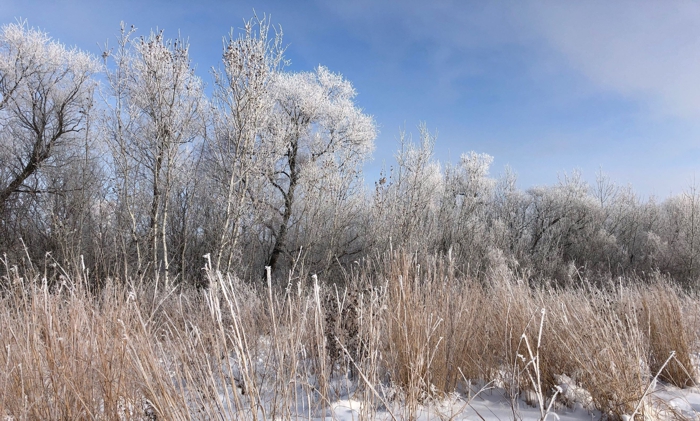
Rime frost (as in this photo) forms under heavy fog conditions (the previous night), causing the supercooled water droplets to freeze on contact with thin objects. Similar-looking hoar frost develops as water molecules undergo direct sublimation on objects, without foggy air. Calm air permits the formation of beautiful crystal formations, which eventually shower to the ground and evaporate. (R. Wrigley)
As I hustled across the parking lot to go skiing in Winnipeg’s Assiniboine Forest this afternoon, my boots made the most pleasant crunching sounds (like munching on toast) on the packed snow. Instead of the old-fashioned cable bindings of my first skis in the early 1970s, I now sported a convenient one-click toe binding, and off I went, shifting from leg to leg with long, smooth glides. It was a beautiful afternoon with a temperature of -8°C, and the brilliant sunlight created countless sparkles of pure delight bouncing off delicate crystals, which had settled onto the top layer of snow.

Who can refrain from experiencing delight at entering a hoar-frosted forest. (R. Wrigley)
This fresh white blanket, reflecting over 50 percent of the solar radiation back into space, reminded me of marzipan icing on a wedding cake, punctured here and there with long thin stalks of golden-yellow grass. Everywhere I looked, snake-like cylinders of snow wound their way, back and forth, along sloping tree branches, and white caps perched like perfectly shaped bread buns on the top of every stump, all appearing like magic from last-night’s gentle snowfall. I was surrounded by a cornucopia of snow sculptures clinging to each shrub and tree. It was so exhilarating to be immersed in Nature’s dazzling-white art gallery, to enjoy at my heart’s content, and admission was free.

The play between snow cohesiveness and gravity present some truly remarkable, snake-like creations on downed trees. (R. Wrigley)

A 'snow ghost' clings onto the side of an old split Aspen trunk. (R. Wrigley)
I examined one particularly graceful snow sculpture at eye level, and dared touch it with my tongue, transforming the delicate crystals to liquid in an instant. What a story might these water molecules (consisting of bonded hydrogen and oxygen atoms) tell about their recent journey, leaping from the surface of the mid-Pacific Ocean, climbing and swirling up into vapoury clouds high into the atmosphere, and then borne by easterly flowing winds over forests, mountains, and prairies, all the while destined to land at my particular spot. Although I could not see them, trillions of these frozen water molecules were leaping back into the air by the astonishing process of sublimation. These molecular migrants have been circulating among the hydrosphere, atmosphere, geosphere, and biosphere ever since they arrived on Earth, bound within countless asteroids, four billion years ago– a period known as the Late Heavy Bombardment.
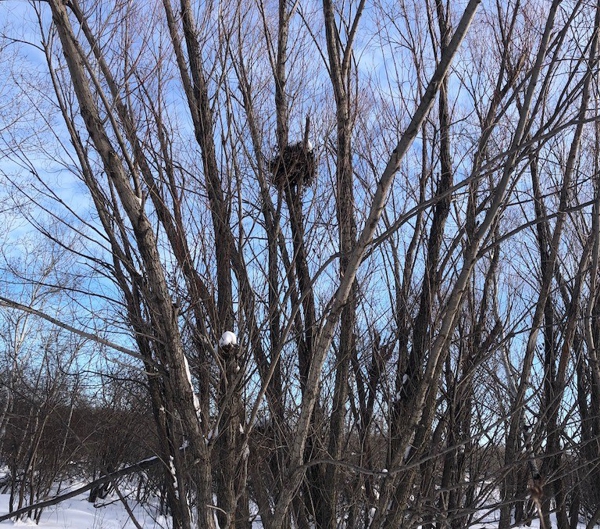
The leaf and twig summer nest of a Red Squirrel in willows may be reoccupied in subsequent years by nesting birds. This nest would be hidden once the trees leaf out. (R. Wrigley)
As I glanced up into the tree canopy, the craggy spires of oaks and aspens reminded me of skeletons, having lost in the autumn their mantle of yellow leaves. I paused often to admire the bold patterns on the Aspen trunks – pitch-black patches and streaks against the white-powdered bark. Numerous fine scratch marks revealed the past passage of a squirrel (Red, Gray, or Northern Flying Squirrel), or an Eastern Chipmunk -- the former three still active all winter, the latter species now hibernating deep below the frost line. Black circles on the trunks marked the former sites of branches that had long since died and tumbled to the ground, their demise the result of decreasing levels of light reaching them as the trees matured. At the base of the oldest trees, yellow and gray lichens had gained a foothold amid crusty-black expansion cracks in the bark, simulating the splitting pants of a girth-gaining senior. I could see on some trunks perfectly aligned series of horizontal holes drilled long ago by a Yellow-bellied Sapsucker (called a ‘zap-zucker’ by my young son) desirous of licking up sweet sap. During the warm season, these temporary sap flows also provided insects and squirrels with a source of energy.

Aspen trunk with a woodpecker hole and black markings; the result of trunk expansion, animal damage, sites of old branches, and fungal attack. The white chalk that rubs off readily consists of shed, mature cork cells which permit sunlight to reach the photosynthetic cells under the cambium layer. Some photosynthesis occurs in early spring, well before leaves develop. (R. Wrigley)
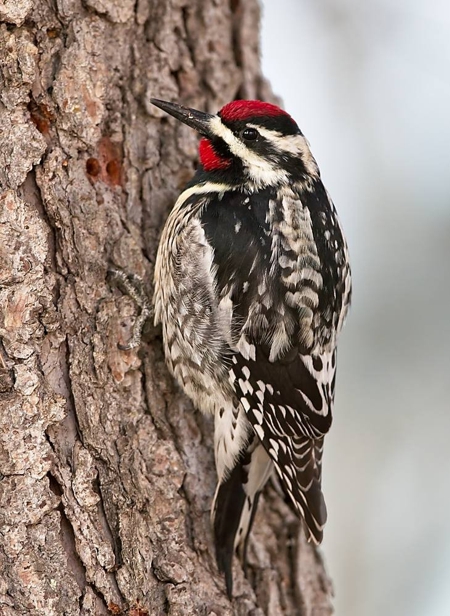
A Yellow-bellied Sapsucker pauses to examine its handiwork in accessing three sap. (Larry de March)

What began as possibly a small hole left behind from a dead branch has been enlarged into a fine nesting site for small mammals (e.g., Northern Flying Squirrel), birds, and insects. (R. Wrigley)
I paused to admire the round, spiky, papery husks of Wild Cucumber strung like Christmas lights from a long vine clambering among the branches of a willow. The bright-red stems of Red-osier Dogwood then caught my eye, always a treat to see piercing the white snow. White-tailed Deer tracks were evident everywhere, crisscrossing the nature trails, yet I have seldom seen a deer here, and then mainly when they meander along the park’s surrounding roads. They must bed down in secluded spots during the daytime.

This Red-osier Dogwood shrub has been browsed repeatedly over the years by deer and rabbits. (R. Wrigley)

Tracks of two deer crisscross in the forest. Note the hoof drags. (R. Wrigley)
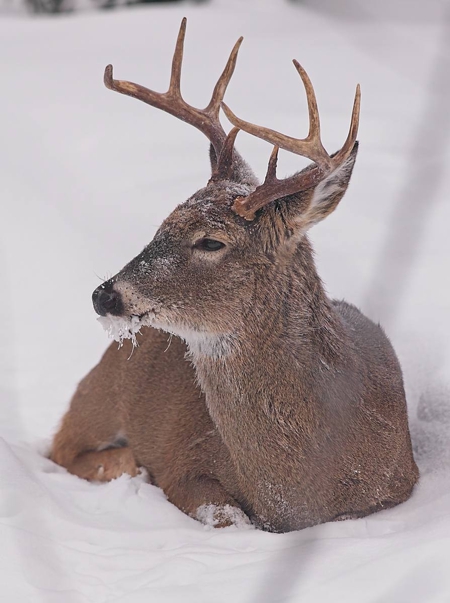
A White-tailed Deer buck bedded down for the day. (Larry de March)
The only sounds I heard most of the time were the alternating swish-swish of my skis and the squeaks from the steel points of the poles penetrating the packed trail. Then, from a distance, a lone Black-capped Chickadee called, and I answered its greeting by whistling a high-pitched ‘dee-dee-dee.’ In seconds, the inquisitive little bird flew over in my direction. As it flitted nervously from branch to branch only a metre or two away, its keen eyes scanning for food, I marveled that such a tiny creature could survive our winters, when insects were securely hidden under frozen bark, and most seeds were covered by snow. This bird can remember rewarding sites in its home range to search for food and sleeping quarters in a tree hollow, and can even enter a state of hypothermia overnight to save energy. Then I heard a far-off triple croaking of a Common Raven, and I did my best imitation by exhaling air over my flapping tongue (which I had practiced with ravens on the tundra). Sure enough, ten seconds later, the raven came over to investigate, and spotting the intrusive impersonator, it banked in a graceful arc and glided away.
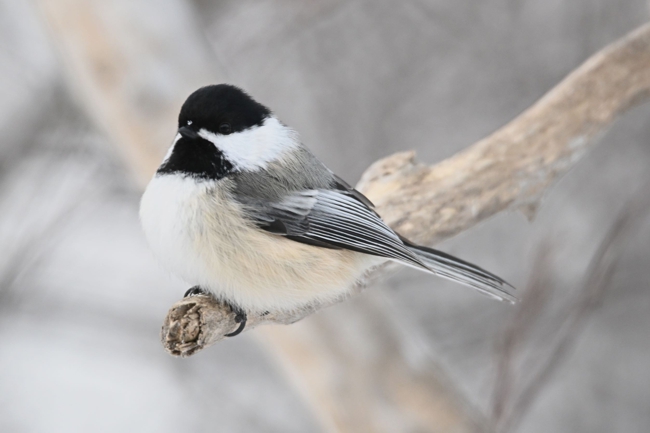
The Black-capped Chickadee is inquisitive, often approaching remarkably close to skiers. (Jim Reimer)
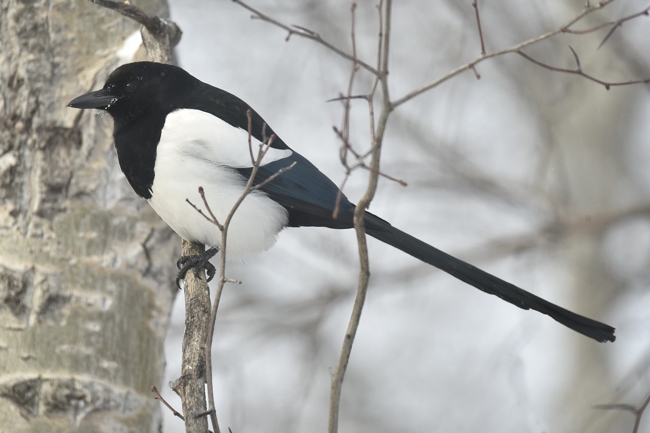
The attractively coloured and winter-hardy Black-billed Magpie is a common species in rural landscapes, often entering cities and towns across the prairies. (Jim Reimer)
When I paused to catch my breath, with the deep silence surrounding me, it was difficult to fathom that in only a couple of months, tens of thousands of birds of dozens of species, having spent the winter from the southern United States to South America, would arrive in these woods, with males singing incessantly to claim territories and to attract a mate. Farther along the trail, I must have intruded onto the territory of Red Squirrel, because it churred boldly, clearly annoyed, and then made itself scarce. I then pulled back some loose bark off a fallen log and uncovered two hibernating red and black click beetles, which during the warm seasons can flip high into the air like ‘tiddlywinks’ when disturbed by a predator. I then thought of the many Woods Frogs I was passing by, each huddled in a near-death frozen state, tucked into the leaf litter.
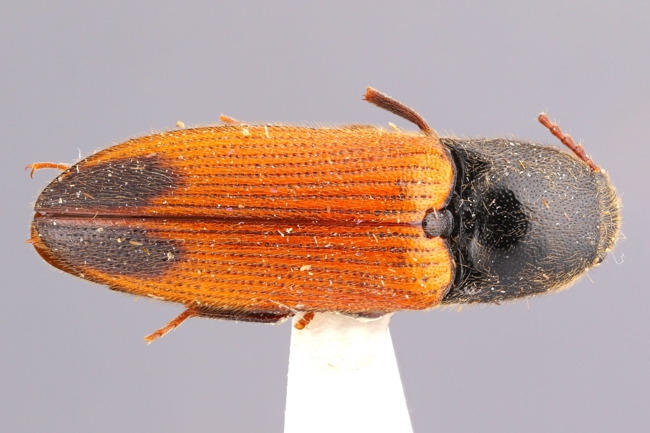
Image poplar click beetle: The 12-mm Poplar Click Beetle (Ampedus apicatus) is covered with dense, touch-sensitive hairs (called setae) which collect debris, perhaps contributing to camouflage protection from birds. Usually protected by an insulating cover of snow while hidden under bark or soil, insects like click beetles can survive intense cold due to physiological adaptations. (Thilina Hettiarachchi)

Squirrels and rabbits must deal with leaping over the snow cover, while birds have the luxury of flitting from branch to branch, in traversing the landscape. (R. Wrigley)
Farther down a trail I came across a 40-cm-high mound of earth and sticks with partially bare earth sides (the snow having fallen off), exposing the dark soil to the warming rays of the sun. It was the home of mound or thatching ants. Over two metres below the surface, the hibernating colony likely consisted of around 100 queens and 40,000 workers, all awaiting the warming temperatures of March, which would enable the ants to commence their designated chores.
Skiing on, I came across scattered pieces of fur and a string of intestine of an Eastern Cottontail Rabbit. Tracks in the snow revealed that a Red Fox had fed well last night. On rare occasions I have found where an Ermine has pursued and devoured a mouse, perhaps lining its own nest with mouse fur. Then I found the delicate trail of a Deer Mouse on the surface, which I could distinguish from a Southern Red-backed Vole by the long lengths of the hops and the obvious long tail mark in the snow. The tracks always led to a plunge hole down into the lattice-like subnivean world amid the frozen leaf litter. An unused hole was usually edged in fine ice crystals, as water vapour from below froze on striking the cold air. I wondered about the accumulation of carbon dioxide trapped at ground level. It is thought that mouse tunnels rising to the surface allow gaseous exchange to occur, for there remains considerable activity of a host of animal life under the insulating cover of snow. In addition to mice, there are shrews, spiders, springtails, centipedes, lice, mites, roundworms, and other tiny lifeforms that continue to thrive in the leaf litter and soil, responding to the slight heat arising from deep underground.

The forest-dwelling Southern Red-backed Vole plows its way over the snow rather than jumping, as does the Eastern Deer Mouse. (R. Wrigley)

Tracks of a Deer Mouse, which emerged from its subnivean tunnel at the base of a sapling. Note the long tail marks. (R. Wrigley)
When I come across a creek bed in a field, I can never resist being drawn down into its inviting valley, and not only because it provides an instant reprieve from a chilling wind. The creek banks are a wonderland of snow sculptures deposited by the wind. A broken grass or weed stem, twisting round and round in the wind, etches a perfect circle on the surface of the packed snow, just as occurs on a sand dune. Later in the afternoon, I noticed that my shadow, which had leapt so energetically ahead of me at the start of the trail, now decided to follow me at a slow pace as I returned to the parking lot.

Strong winter winds burst apart the sturdy flowering heads of cattails, scattering the seeds across the snow. (R. Wrigley)
Anyone who skis in wild areas will have stories to tell about coming across wildlife. On one occasion, I was striding along, lost in thought, when there was a sudden explosion in front of my ski tips, which really startled me. I had come across a Spruce Grouse sleeping under the snow. Several times I have found the plunge hole and wing marks in the snow where a large owl (likely a Great Horned) thrust down its taloned legs in hopes of capturing a mouse. While skiing in Riding Mountain National Park, my wife and I were enjoying the solitude of the boreal forest early one morning when I heard the unmistakable sounds of a bull Moose thrashing its antlers against a shrub. I cautiously peered over a slight rise and observed the massive animal glaring back in my direction. That impressive rack convinced us immediately to intrude no further on his territory, especially while the rut may have still been underway.

(R. Wrigley)
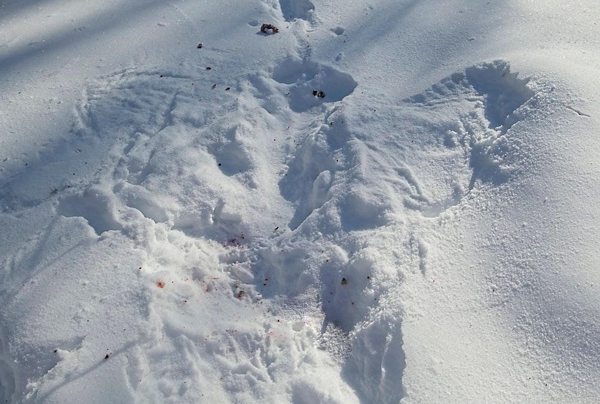
Evidence where owls plunged through the snow with their taloned legs for mice. (Larry de March)
On another occasion*, as a friend and I were driving down the street that borders the Assiniboine Forest, on our way for a morning ski, we noticed two White-tailed Deer bucks suddenly start bounding alongside us, parallel to the road. Seeing that they would not veer off into the adjacent field, we presumed they wanted to return to forest, so I slowed down to give them a chance to cross the road safely. Unfortunately, the road was icy, and as the first buck reached the pavement at considerable speed, its four legs spread out awkwardly, and it slid upright into the snowbank, managed to recover its balance, and then headed off into the woods. Its companion decided to follow, but its front legs swept out to one side mid-way across the road, and it went down heavily on its side, striking its head rather hard on the pavement. Its right antler snapped off at the base and went skidding along with the deer, which finally slammed into the bank. I thought the animal might have suffered a severe injury, such as a broken leg or concussion, but it rose quickly, and made its way into the forest. I felt some guilt for having caused the accident, but hoped the deer had learned how to better react to traffic. Deer-vehicle collisions are sadly not uncommon on busy roads through forested areas.
With snow on the ground for four to five months in Manitoba, skiing is a wonderful way to enjoy bright sunny days outdoors. Even on frigid days with a wind-chill, trails winding through a forest provide shelter until one’s body warms up from the exercise. There is plenty to investigate on each excursion, revealed with a sense of curiosity and a little knowledge.

Dazzling-white sculptures abound where a playful wind decides to deposit its load of snow crystals. (R. Wrigley)
*Story from the author’s book: “Chasing Nature: An Ecologist’s Lifetime of Adventures and Observations.” by Robert E. Wrigley
